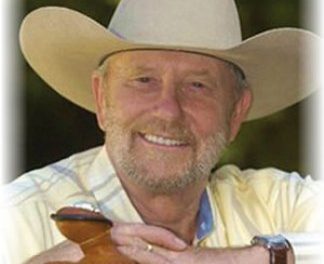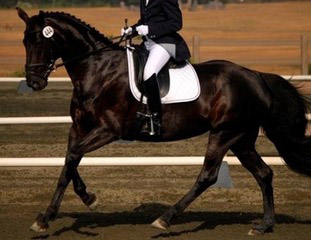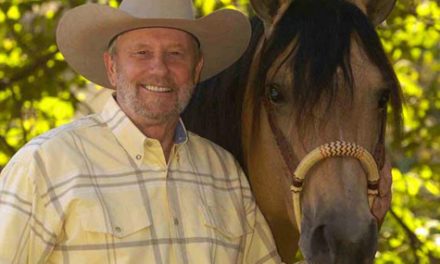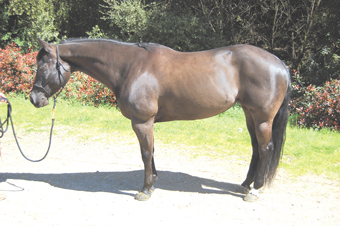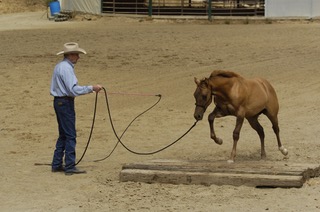
I’d like to discuss what causes a horse to rear and how we can actually set a horse up to rear. There are two basic facts to consider. Horses learn by pressure and release and, a horse can go six different directions: forward, back, left, right, down and up. If you think in those terms, when we work with a horse, we always have to give the horse a way out, a way to find release. If you try to close off all the directions, the horse is going to take one of the directions that you can’t block. In other words, you may not get the response you wanted and the horse may go a direction that you didn’t want at all. For example, if we want our horse to go over a log, a tarp, a pole, through a creek or toward anything that the horse does not want to go near, 99 percent of the time the horse will go left or right or, it may stop and back up. Even if the horse is following another horse who goes right through the creek, for example, he may just have an issue and be afraid to follow. What most people do in that situation is to block the horse from going right or left and the horse will start to back. If the rider then applies the spurs as the horse backs, the horse will likely go up.
When I am teaching a horse to go over objects, I will block the horse from going right or left because if you let the horse go to the side, it becomes an escape route and the horse will not deal with the issue of crossing the object. I block movement to the right and left but the moment the horse starts to back up, I let the horse move back. If he wants to back up five feet, I let him back up five feet. This is based on the horse having a good, solid forward cue. As soon as the horse stops, I ask him to go forward. In the saddle, once a horse has stopped, you can apply the spurs or give the horse a good, aggressive kick to get him to go forward again. A firm forward cue is fine, but only after the horse has stopped. Wherever the horse stopped is where he feels comfortable about whatever it is that he is dealing with. If we apply the forward cue while the horse is backing up, I can guarantee the horse will rear. The horse is too uncomfortable to go forward at that time. This is a common situation. The horse has too much anxiety and when the rider tries to force the issue, the horse rears.
Another situation where a horse may react by rearing can occur when a horse will not accept contact. This can be a hackamore or a bit, anything that is controlling the horse’s face. If you make contact and ask the horse to go forward and the horse hasn’t accepted the contact, when you block all the other directions, the horse will go up in the air.
Another time that a horse may rear, and I’ve seen this many times, is when a horse has anxiety about going home. A horse that is barn sour or does not accept separation from a buddy may buck or rear. Forcing a horse away from the barn or away from his buddy causes a certain amount of anxiety. The farther away from the barn or the buddy, the more anxiety. The barn or the buddy represents the horse’s comfort zone. The thing to do for this is to go back to the barn and go out again. Going toward home releases the anxiety. Take the horse out a little and go back, expanding the distance and time away from the barn. It may take several lessons to build the horse’s confidence to go away from the barn or go out on the trail alone.
You might be out on the trail with another rider who takes off going a direction that you do not want to go. Your horse may get upset because the other horse is leaving. The normal response is to try to force your horse to go the way you want to go. As the other horse gets further and further away, the anxiety of your horse builds. The more you force the horse away from his buddy, the more likely it will be that the horse will rear. You may need to go with the other horse. Ask your companion to not ride off. If your horse is extremely upset, you may need to get off and walk him for a bit. You can let your horse go toward the other horse and turn him slightly away, relaxing the rein when he yields for even one step. Set up a time to work with another rider on separating and coming together to reduce the anxiety and buddy sour behavior.
Then there is the horse that wants to race back to the barn or gigs all the way back. The more you hold the horse back, the more anxiety and tension you create. Or, the friend you are riding with decides to canter off and you are not comfortable cantering. Again, the more you hold the horse back, the more likely it is that the horse will buck or rear. Let the horse go forward at a pace you are comfortable with. This may be a trot or easy jog. And, ask your friend not to take off like that again. Any time you ride with a companion you should both practice courtesy and be aware of the problems that can be caused when one rider abruptly starts to gallop.
Back to the creek situation; your horse finally gives a huge leap and jumps over it. He jumped but you wanted him to walk through the creek. Most people will catch the horse in midair, or not allow the horse to jump, in other words, they’ll shut it down. This doesn’t work because the horse doesn’t want to be at the creek in the first place. The result will be that the horse will rear. So, what do we do? We let the horse jump the creek and go fifteen or twenty feet forward and when the horse is a little quieter, we turn the horse back and let him jump the creek again and go a little further. We wait till the horse is quiet and go back and let the horse jump the creek again. We keep repeating this, shortening the distance each time. Pretty soon the horse is trotting across the creek or running or even bolting but, it is better than jumping. Eventually, the horse should cross at a quiet canter or a walk. A horse is not comfortable about crossing a creek until it will walk across calmly. This too may take many repetitions and require a lot of patience on your part.
The natural reaction of some horses to new or different situations, no matter what, is to be light in the front end. You can give them all the positive escape routes and their natural reaction is to go up. This is a small percentage of horses. Every time the horse comes up to something he doesn’t like, an object he is not secure about, he rears. Then we have to create a way for the horse to change its reaction. I can usually feel it coming and it is not a good feeling. What I do is take the horse to the right or left, even when the horse is up in the air. I get the horse to go forward a few steps and then turn the horse back into the object it is avoiding. This must be done with good outside rein and outside leg control. It may be a slow process because going to the right or left is an escape route but if we do not give this type of horse that option, it will rear. I release the pressure by letting the horse go right or left for two or three steps, and then once the horse has relaxed a bit, I turn it back into the object. I have found this to be a successful response to this type of behavior.

